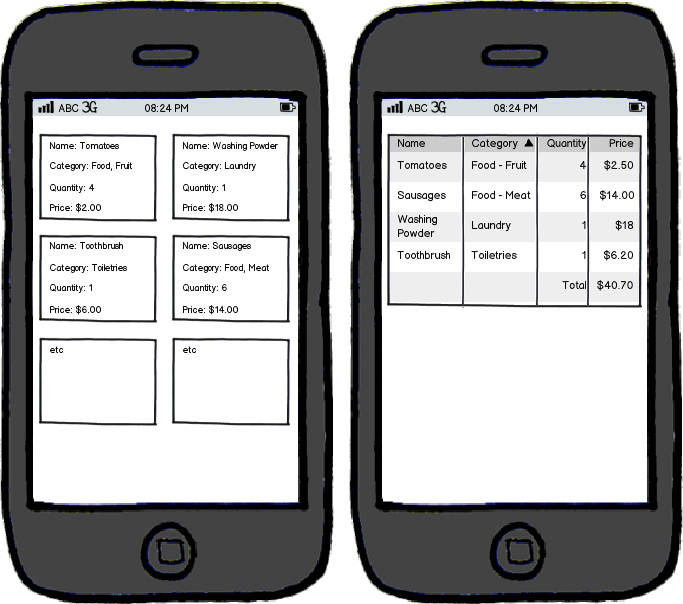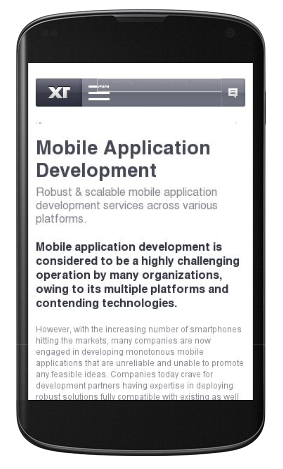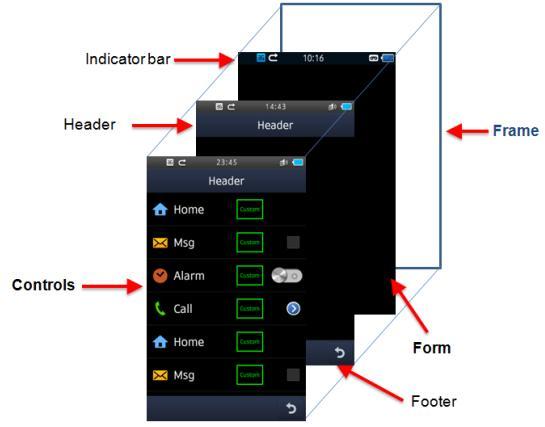
Though there are a number of considerations that need to be kept in mind while building a mobile application, user interface is the prime one. If you're successful in developing an intuitive user interface for your app, then nothing can stop you from attaining the reputation of a professional mobile app developer. If you too belong to the mobile app development company and are keen on developing an outstanding mobile interface, then this is a post which will take you in the right direction. Here, I've covered six simple tips on creating a user-friendly and utmost professional interface for your mobile application. So, let's get on with these tips!
1. Choose the right mobile layout
 It is advised to take full advantage of the different varieties of mobile layouts that are available for purchase. Make sure the mobile layout you choose for designing the app's user interface offers you an easy and intuitive way of organizing and aligning all your information in the best possible manner. Do remember, the basic mobile layouts are being segregated into three main categories viz: the one with a footer, the one with a menu bar and footer and finally the one with no footer or menu bar.
It is advised to take full advantage of the different varieties of mobile layouts that are available for purchase. Make sure the mobile layout you choose for designing the app's user interface offers you an easy and intuitive way of organizing and aligning all your information in the best possible manner. Do remember, the basic mobile layouts are being segregated into three main categories viz: the one with a footer, the one with a menu bar and footer and finally the one with no footer or menu bar.
2. Make a good note of the targeted screen density
 Screen density basically refers to the screen resolution which is measured in dots per inch(DPI). It is vital for you to classify the mobile devices on the basis of their individual screen sizes and densities. For instance, two mobile devices belonging to the same brand can have similar screen sizes but might differ in terms to screen densities. Here, it is important for you to remember that the screen density starts from as low as 120 DPI witnessing a gradual increase to medium, high and extra high values for screen density.
Screen density basically refers to the screen resolution which is measured in dots per inch(DPI). It is vital for you to classify the mobile devices on the basis of their individual screen sizes and densities. For instance, two mobile devices belonging to the same brand can have similar screen sizes but might differ in terms to screen densities. Here, it is important for you to remember that the screen density starts from as low as 120 DPI witnessing a gradual increase to medium, high and extra high values for screen density.
3. Embrace High Resolution Images while ditching the heavy graphics
 Today, all the smartphones feature high resolution screens. Therefore, as a mobile app developer you need to switch all your low-resolution images into high-resolution images. Make it a point to get rid of all the heavy graphics which have been incorporated into the app's interface. Doing this will give a fresh and attractive look to your mobile UI, thereby rendering an excellent user experience to the users. I recommend using the vector-based images simply because can get automatically scaled to fit the resolutions of the targeted mobile devices.
Today, all the smartphones feature high resolution screens. Therefore, as a mobile app developer you need to switch all your low-resolution images into high-resolution images. Make it a point to get rid of all the heavy graphics which have been incorporated into the app's interface. Doing this will give a fresh and attractive look to your mobile UI, thereby rendering an excellent user experience to the users. I recommend using the vector-based images simply because can get automatically scaled to fit the resolutions of the targeted mobile devices.
4. Plan the flow of functionality within the mobile application
 Well, we all know that the basic purpose of a user interface is to let users know the way in which they can use the particular mobile app. Since you'll not be there to assist https://buyklonopintabs.com each and every user while he/she is busy exploring your app, it is essential to offer all the cues needed by him/her via the app's interface. You need to plan the flow of functionality within the app by finding appropriate answers to some vital questions like these:
Well, we all know that the basic purpose of a user interface is to let users know the way in which they can use the particular mobile app. Since you'll not be there to assist https://buyklonopintabs.com each and every user while he/she is busy exploring your app, it is essential to offer all the cues needed by him/her via the app's interface. You need to plan the flow of functionality within the app by finding appropriate answers to some vital questions like these:
Does it sound obvious for the user as to where he/she needs to start and what he/she needs to do next?
Is it actually vital that all the tasks are being performed in a set order of steps?
Has the intended outcome been stated or implied(either implicitly or explicitly)?
5. Setting the hierarchy of UI elements is necessary
 It is worth noting that not everything within a user interface or a mobile layout holds the same amount of significance as everything else. It is here that the role of hierarchy comes to play. Well, hierarchy is basically the arrangement of UI elements in a way that represents what all is higher in order, the elements that come next and so on.
It is worth noting that not everything within a user interface or a mobile layout holds the same amount of significance as everything else. It is here that the role of hierarchy comes to play. Well, hierarchy is basically the arrangement of UI elements in a way that represents what all is higher in order, the elements that come next and so on.
6. Make the best use of popular icons
![]() With a wide array of icons available for your use, make sure to choose the ones that can highlight the intuitiveness that's been incorporated in your mobile application. Make sure to understand the functioning of an icon before using it for your mobile application.
With a wide array of icons available for your use, make sure to choose the ones that can highlight the intuitiveness that's been incorporated in your mobile application. Make sure to understand the functioning of an icon before using it for your mobile application.
Test the app's interface if you're looking forward to translate your app into different languages
Mobile app localization is undoubtedly one of the best techniques of making your app reach a wider group of targeted audience/. Hence, it is recommended to test the app's interface on a variety of scripts. You must keep in mind that the amount of space occupied by a specific message displayed on the app is drastically different for different scripts. For instance, while the East Asian scripts require lesser words on an average, the middle-eastern scripts like Arabic go from right to left instead of the typical left to right method of reading a piece of text.
Final Thoughts
A lot of planning and hardwork goes into creating an outstanding user interface for your app. I seriously hope the above mentioned Mobile UI tips would enable you to ensure an intuitive status for your mobile user interface-something your users are going to appreciate for sure.
About the Author-
Amanda Cline is a web developer with an excellent track record of having delivered simple and complex web development projects. Currently employed with Xicom Technologies Ltd. – Web Development Company, Amanda can serve as an excellent asset for your web development project. If you’re looking forward to hire developer then you can get in touch with here via – @amandacline111
